The tale of how the Japanese stole the idea of a mini-Rover from Soviet engineers GAS
GAZ M-73 “Ukrainian” 1955 vs Suzuki X-90 1995: historical comparison
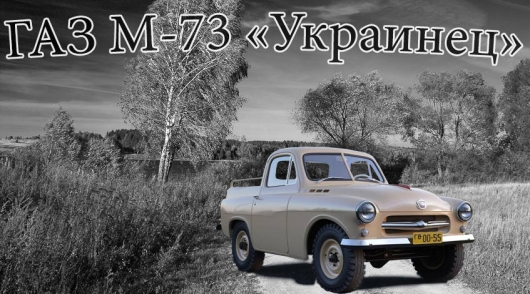
Within two years, from 1995 to 1997, Suzuki has released for the European market strange four-wheel-drive two-door crossover built on the scheme of the drive – 4WD. This car was a non-standard name “X-90” and no less strange appearance, something between a compact coupe and crossovers in those years. 4×4 chassis from the last, and the body – from the first.
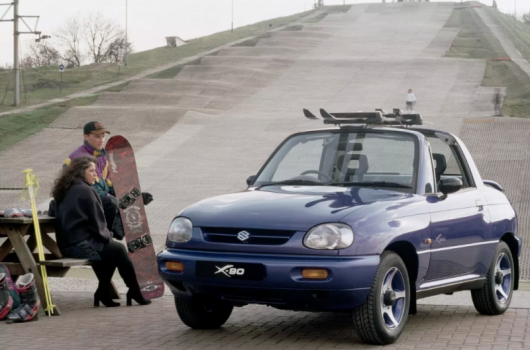
The proportions were strange, destiny was strange, the whole concept was strange, maybe that’s why around these cars instantly formed its own fan-crowd, but a popular model and did not. Two years was the limit, after which the experiment does not make sense to continue. The use of car was not enough, the permeability of it was slightly higher than that of conventional cars, and very small size were talking about … not great roominess and practicality. Of course, this was just another feverish dream about the Japanese innovation of the 90-ies.
But was it that Japanese innovation? No! Because a car with similar design concept, but with real possibilities on the off-road appeared 40 years before… in the Soviet Union. His name was GAZ M-73 “Ukrainian”.
Gorky automobile plant, the city of Gorky, now Nizhny Novgorod, 1954

M-73 was the idea that the workers of the Country of Soviets needed a good machine for agricultural purposes. Farms and millions of farmers needed a convenient, modern and passable car, which will not frighten the spring thaw and brought a winter storm unpeeled thread of a rural road. Needed something that could pass through the rougher terrain, the same in its characteristics SUV GAZ-69, but with a more civilized level of comfort, with the amenities of a passenger car, the style of the car, providing protection from weathering. The latter was especially important in cold, wet Russian winter, when the canvas top of the “Russian jeep” turned into icy snowball.
Taking the pencil the task, the GAZ factory has developed a completely new car, with its chassis and all-wheel drive systems 4×4 part of the jeep GAZ-69, in part, applying their unique design, equip its small 1.1-liter inline four-cylinder engine from a passenger car “Moskvich”, which was done in those days, the powerful 35 horsepower. The body was designed in the carrier variant (according to others, he was framed, but this is unlikely to be because the novelty was unified with the base production model Moskvich-402, at which the frame was not). That is, to a certain extent, this little car ahead of global auto industry, becoming one of the first crossovers in the world!
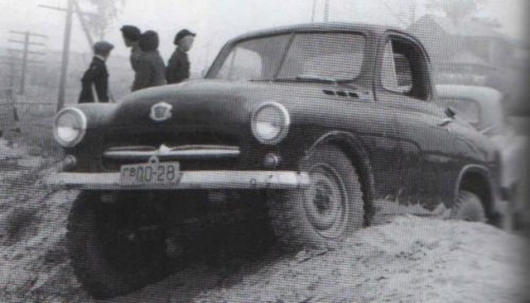
But the shell was designed with a clean slate, and she in 1954, it seemed quite stylish and contemporary, despite the fact that body proportions seemed a bit strange.
Interestingly, some historians, especially abroad, believe that the unique style of SUV superior from the USSR strongly influenced the design of postwar American car models from the early 1950s, years. Especially the similarity is emphasized by the presence of three dotted holes on each side of the hood, which resembled the ventilation holes of the Buick.
In principle, to a certain extent, this theory has under itself soil. In those years the American school of design was in favor, and the European evolved on the ruins of the great war, so in many cars it was a sin not to make use of stylish appearance, especially that in General, the exterior had no analogues in the world, Yes there – he was INNOVATIVE!

For those detractors who believe that the domestic school of design and did just that stealing other people’s ideas, recall that the modern manufacturers in industrial scale are other people’s experience by hiring leading specialists in this field. The same American car companies are perfectly mastered the industry of outsourcing. The design of the new Cadillac models, GM and Ford are now developing European specialists. Our young designers, recent attilasoul war, self-made studies in English, peeping ideas from foreign catalogs, but adapting them in their own way. Cough, cough, and someone who still plagiarism?.. This was a small digression. Continue the history.
Bodies should be different, there should be a lot!
By itself, the body was completely original and built specifically for the new chassis. The design took George M. Wasserman (not to be confused with Anatoly Aleksandrovich Wasserman is an intellectual and scholar). There were produced two prototypes in two body styles: two-door coupe…

…and a small wagon, which theoretically could be used as not only a passenger car of the raised passableness, but as microperimetry carrier, light cargo:
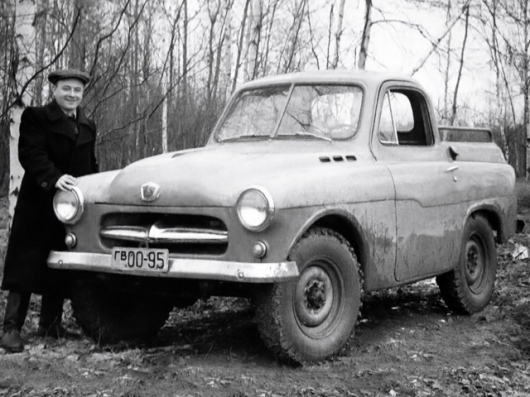
Note the door under the “bed” of open space – in this Department you can hide various small things, such as the tool for car. The storm then it already was not terrible. Similar to the hidden bins are difficult to find, even in modern big pickups except the Honda Ridgeline have the same functionality in the compartment, but here is…! Know what it says? About the soundness of the design. Developers have approached her to design and detail with high degree of responsibility. They knew that the midget in the absence of a large space had to have many additional places where the driver could hide something important and valuable to him.

Sources give the following characteristics of the model:
“Transfer case, suspension and axles were designed specifically for this machine, resembling in design the reduced versions of respective units of the GAZ-69, but unified in a number of parts, mainly the brake system, with the “Muscovite” (data from Wikipedia).
The car was a three-stage transmission from 402 to three gears, unique compact two-stage transfer case transmission with gear ratios of 1.16 and 2.69 and continuous bridges of special design.
Length – 3.440 mm, width – 1.660 mmheight 1.655 mm, ground clearance – 220 mmand wheelbase of 2,000 mm. Gauge: rear – 1.360 mm, front – 1.335 mm. Weight – 1081 kg. Due to the short base of small overhangs and small mass compared to other vehicles with four-wheel drive prototype showed during the winter and autumn trials 1955 outstanding permeability. Virgin no dirt, no loose, deep snow was not an obstacle for M73 “Ukrainian”.
Their contribution has made a 16 inch (!) the wheels are shod in narrow mud tires. These tires were digging the soil, not allowing the machine to get stuck on the roads. But speed tests revealed a dislike of the man to speeds of over 70 km/h – impact two-meter base. The car felt uncomfortable at speed.
The fate of the GAS model M73 “Ukrainian”
As for the surviving copies of the model, it seems that they are not. From contemporary photographs, we calculated only a few have enough high-quality rendering of the photo, nothing more:

All that was left as a legacy, photos of prototypes, overcoming snow and mud, technical documentation, sent to the capital at the plant MZMA (AZLK). Where are the documents now, is not known.
However, although M73 in the series and didn’t go, working with it is still used, however, a different automobile, the “Muscovites” series 410, 411.
Suzuki X90 – the ancestor of M73 GAS?
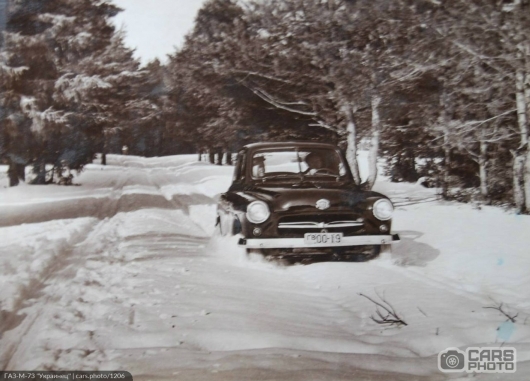
It’s been 40 years. Suzuki X90 presented. The car received almost the same proportion, purpose and arrangement that the Soviet pioneer. Although there is no evidence that Suzuki stole the idea from M-73, but something tells us that everything new is well forgotten old. And the Japanese decided to try again. Good or bad? In our opinion, good. If an unusual variant of the design has gone in one time in one country, why not try to do the same many years from other professionals? This is not stealing, it is the continuity of ideas. However, what happened to the model X-90, we also know.
The idea is stillborn? Or, on the contrary, people just are not Mature enough to of these machines? Maybe we should wait another couple of decades and then try again? Only time will tell.
